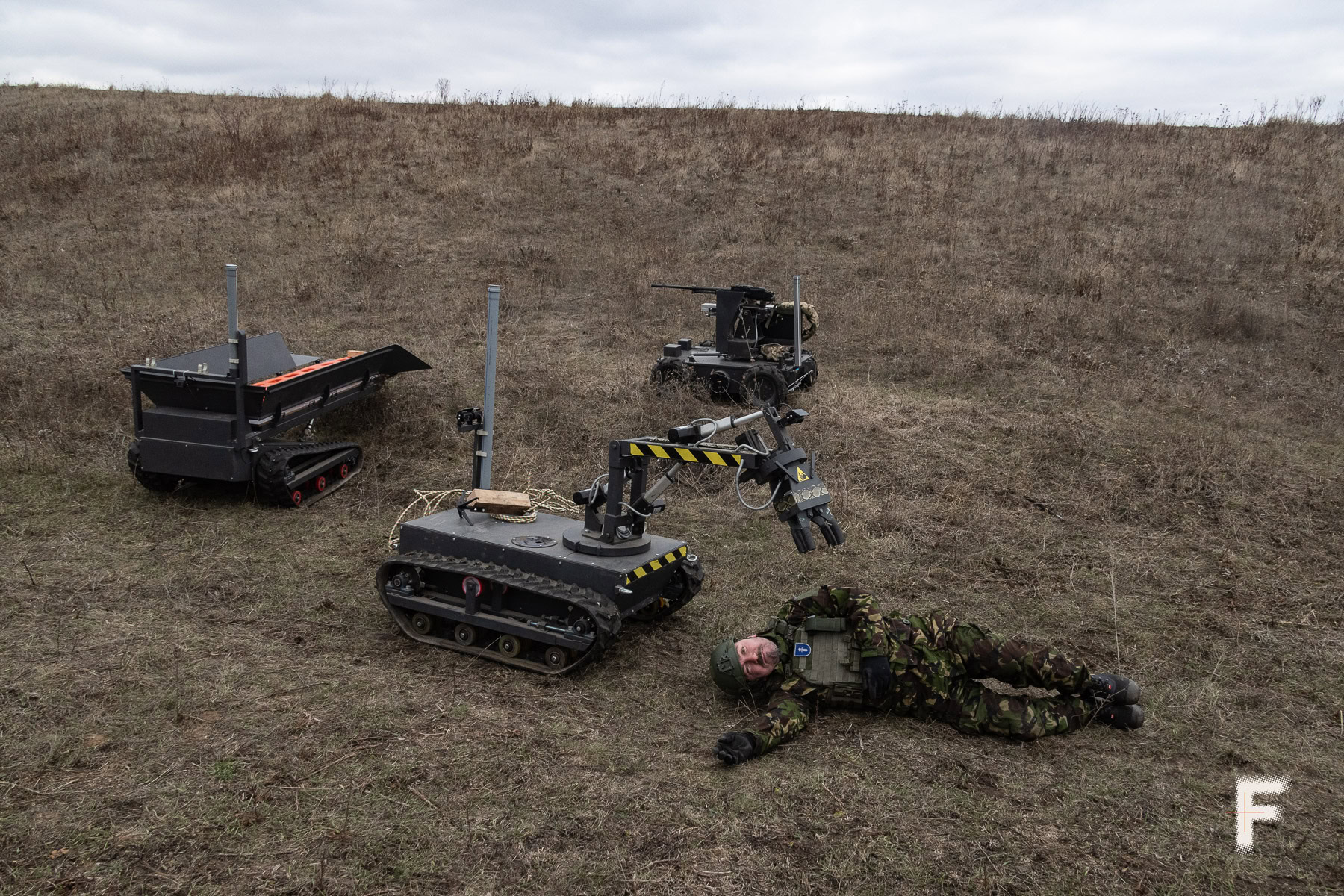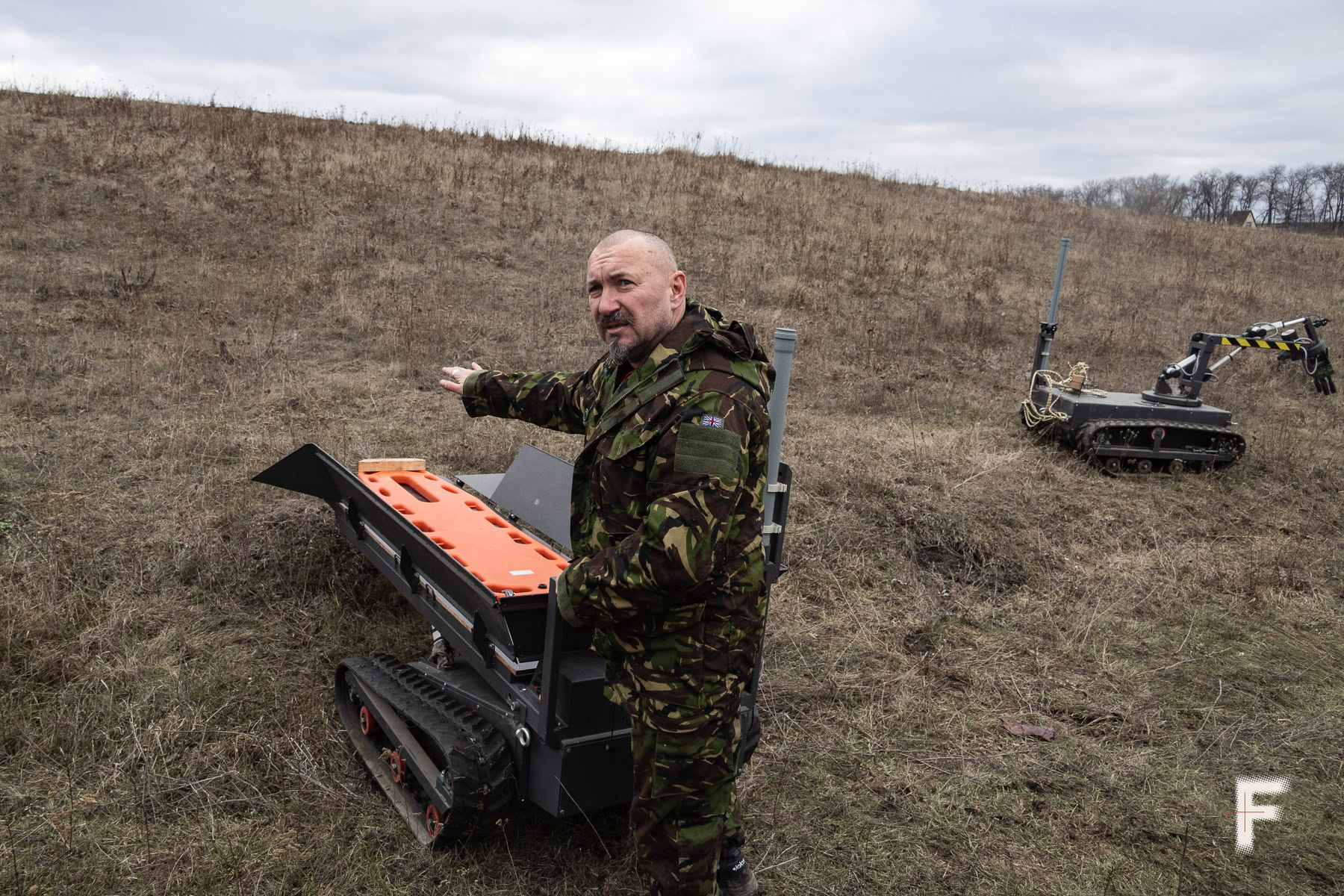Finnish volunteer Kirill Rinne takes part in the production of unmanned ground vehicles (UGV) in the northeastern Ukrainian city of Kharkiv to evacuate wounded and fallen soldiers from battlefields without risking additional lives. Frontliner tells his story.
Kirill Rinne has been supporting Ukrainian forces for three years since Russia’s full-scale invasion in 2022, while also transferring combat experience to his own country to prepare Finland’s defenses if needed. He believes these robotic systems will revolutionize battlefield rescue operations.
“I don’t believe Russians would attack Finland – just as I didn’t believe they would attack Ukraine,” Rinne told Frontliner.
Kirill Rinne has Finnish heritage through his father and Armenian-Russian roots through his mother. Speaking Russian since childhood enabled him to head Canon’s office in Russia after several years with the company. After over a decade in St. Petersburg, Rinne and his wife chose to return to Finland for their son’s education and safety, according to Frontliner.
Rinne was shocked by Russia’s full-scale invasion on 24 February 2022. Images of destroyed cities and killed civilians reminded him of the Winter War launched by the USSR against Finland in 1939. He felt fury and disgust, seeing what he described as “hordes of drunk boatswains” and “toothless outcasts” once again invading a peaceful neighbor.
For Rinne, Russian terror isn’t just a historical concept but a family trauma. His great-grandmother was born and lived in Karelia, but had to flee her home after Finland’s defeat in the Winter War.
Supporting Ukrainian defenders
Seeing Ukrainian resistance against Finland’s historical enemy, Rinne contacted a friend from Kharkiv serving in the Kraken special unit. Asked how he could help, the friend responded: “We have nothing.”
“They were only issued Kalashnikov rifles. Not everyone had body armor or equipment, some didn’t even have uniforms,” Rinne recalls.
He began buying equipment with his own funds, filling several 200-liter bags with camouflage suits and nets. Rinne sourced night vision scopes, secured 20 body armor vests from a Lithuanian friend, and received computers and mobile phones from a business contact for Ukrainian forces.
At the time, fighting continued on the outskirts of Kharkiv, with Russian forces launching repeated airstrikes in an effort to breach the city’s defenses. While Rinne’s companion initially felt confident about the route, he backed out after seeing footage of the shelling. Kirill, however, told Frontliner he was prepared to take the risk to deliver aid to his friends.
“I’ve had quite a full life. I’ve traveled around the world, raised two sons, seen and experienced many things. At that point, I didn’t have any mission I needed to accomplish. Except perhaps having a daughter I could spoil,” Rinne says.
Upon arrival, Rinne found Ukrainian defenders equipped with weapons, but some volunteers lacked proper gear, fighting in jeans and sneakers. The reception moved him—he later said he felt like “Santa Claus for adults.” Whether the supplies helped or not, he hoped they had saved at least one life. In the following months, he stayed in touch with the military and continued delivering essential equipment himself, driving thousands of kilometers from Helsinki to Kharkiv in his minibus.

Evacuating wounded soldiers
Rinne later faced another pressing challenge. In 2022, Ukrainian hospitals were overwhelmed and unable to provide adequate treatment and rehabilitation for all the wounded. He recalled then-Finnish Prime Minister Sanna Marin’s public statement declaring Finland’s readiness to receive injured Ukrainian fighters “as their own.” Yet, according to Rinne, the government took no action—prompting his frustration.
Ukrainian ground drone rescues three wounded soldiers stranded for month
The volunteer arranged the evacuation of 13 wounded Kraken unit soldiers to Finland, giving doctors their first experience with combat injuries—something Rinne said was as vital for the medics as for the fighters themselves.
“They still need experience. If Russians attack Finland now – although I don’t believe in this, just as I didn’t believe they would attack Ukraine – doctors should have at least some experience, even if minimal,” says the volunteer.
Since then, every trip to Ukraine has involved delivering a full minibus of military equipment—and bringing wounded fighters back to Finland for treatment on the return leg, Kirill told Frontliner.
Drones in Finland
“A drone isn’t some ‘precious treasure’ that should cost 20,000 euros. It’s a consumable that can be made for pennies,” says Rinne.
Kharkiv land drone production
By early 2025, Kirill Rinne had shifted his focus from supplying military gear to addressing one of the battlefield’s most urgent and complex tasks: evacuating the wounded and retrieving the dead under fire, Frontliner says. The Finnish volunteer had spent years delivering equipment to Ukrainian forces and helping organize medical treatment abroad—but evacuation remained a critical gap.
During the war, Rinne had assisted families of fallen Finnish fighters—handling death confirmations, coordinating DNA tests, retrieving remains, and escorting them back to Finland. These experiences raised difficult questions: how can casualties be evacuated without exposing other soldiers to danger? How can this be done under fire? And how can the dead be recovered respectfully?
The solution, he believed, lay in ground-based drones. Rinne reached out to a drone manufacturer in Kharkiv and pitched a concept. Together, they developed a system of unmanned ground vehicles including a sapper drone, an automated turret, and an evacuation platform. Though these UGVs have yet to be deployed in combat, Rinne currently envisions them as a kind of drone-powered ambulance unit, ready to respond to battlefield requests.

Rinne’s drone evacuation system begins with aerial reconnaissance to assess threats and locate casualties, after which a ground drone navigates in for recovery. Bodies are either loaded with a manipulator or dragged by hook, the latter needing only one operator. If under fire, a turret-equipped support drone provides cover—this full scenario was tested in January 2025, with Rinne acting as the casualty, according to Frontliner.
Read also
-
Ukraine clears UNEX UGV amphibious drone for army use
-
Ukraine tests over 70 land drones
-
Ukraine MoD green-lights 900 weapons in 2024, including 600+ domestic items
-
Ukraine military deploys dozens of ground robots, UAVs, FPV drones in historic combat operation in Kharkiv Oblast
-
Ukraine issues 106 military drone development grants


